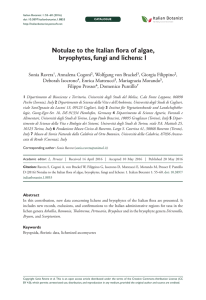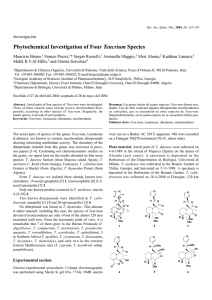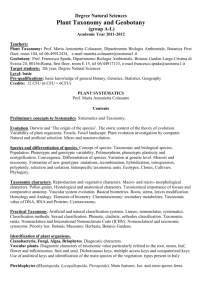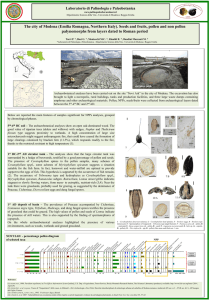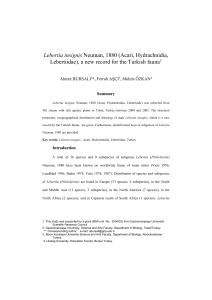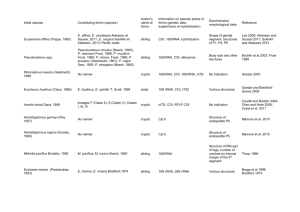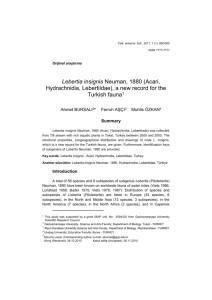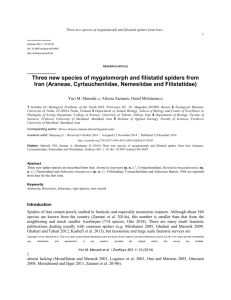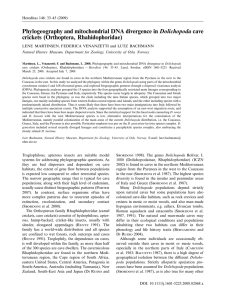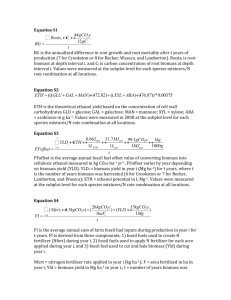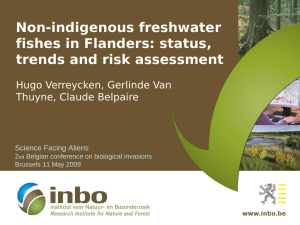Fuga da El Diablo. Il professionista: 4
advertisement
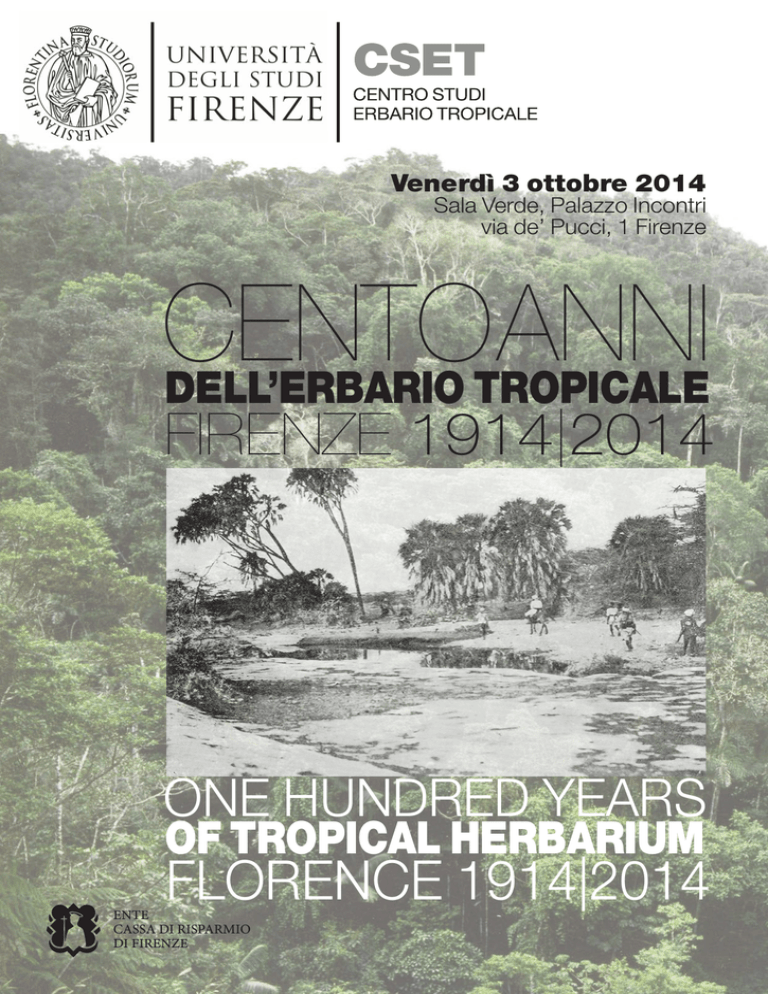
Venerdì 3 ottobre 2014 Sala Verde, Palazzo Incontri via de’ Pucci, 1 Firenze CENTO A NNI DELL’ERBARIO TROPICALE FIRENZE 1914|2014 ONE HUNDRED YEARS OF TROPICAL HERBARIUM FLORENCE 1914|2014 ENTE CASSA DI RISPARMIO DI FIRENZE CENTO ANNI DELL’ERBARIO TROPICALE A FIRENZE (1914-2014) ONE HUNDRED YEARS OF TROPICAL HERBARIUM IN FLORENCE (1914-2014) Ore 9,30: Caffè di benvenuto Saluto delle Autorità ALBERTO TESI, Magnifico Rettore dell’Università di Firenze CRISTINA GIACHI, Vicesindaco del Comune di Firenze, Assessore all’Educazione, Università e Ricerca GIAMPIERO MARACCHI, Presidente dell’Accademia dei Georgofili PIERLUIGI ROSSI FERRINI, Vicepresidente dell'Ente Cassa di Risparmio di Firenze MARCO BAZZICALUPO, Direttore del Dipartimento di Biologia, Università di Firenze Ore 10 Introduzione: RICCARDO M. BALDINI, Direttore Centro Studi Erbario Tropicale, Università di Firenze CHAIRMAN: GUIDO MOGGI, Decano della Botanica Tropicale fiorentina IB FRIIS (University of Copenaghen, Denmark) New light on R.E.G. Pichi Sermolli’s plants from the Lake Tana expedition in 1937 – an important collection from Ethiopia at FT [Nuovi dati sulle raccolte di R.E.G. Pichi Sermolli al Lago Tana: un’importante collezione di piante dell’Etiopia a Firenze] At the early age of 24, R.E.G. Pichi Sermolli (1912-2005) travelled to Ethiopia as member of the Missione di Studio al Lago Tana, staying in Ethiopia from January to April, 1937. The expedition was organised by the Centro Studi per l’Africa Orientale Africana under the Reale Accademia d’Italia. The expedition resulted in 2649 collections. During the subsequent years of war, Pichi Sermolli was occupied with mapproduction for the army, with no time for his collections. But in 1946-1947 he was able to identify his Ethiopian plants on visits to Geneva, Paris, Kew and London. While the first set of the collections were deposited at FT, Pichi Sermolli systematically distributed duplicates to other major European herbaria with significant holdings of African plants. In 1951 he published a comprehensive treatment of his collections. The 35 new taxa and 11 new combinations in that work are reviewed here with indications of their taxonomic position in the Flora of Ethiopia and Eritrea. Some of the characteristic Ethiopian highland species are among the taxa still recognised. Pichi Sermolli itinerary is here outlined and his collecting localities identified and georeferenced as precisely as possible. The localities are projected on a map of the potential natural vegetation of Ethiopia produced in 2010 by I. Friis, Sebsebe Demissew and P. van Breugel. Pichi Sermolli’s observations on the vegetation are compared with the modern map. Pichi Sermolli’s collections from the Lake Tana expedition mark a change in the history of the Erbario Tropicale, from a relatively closed colonial herbarium towards a herbarium with increasing international orientation. Pichi Sermolli early experiences in Ethiopia resulted in a lifelong interest in the plants of Ethiopia, and he attempted with his students to produce a precursor (Adumbratio florae Aethiopicae) for the flora of the Horn of Africa. HENK BEENTJE (Royal Botanic Gardens, Kew, UK) Science comes from collaboration and communication: the Flora of Tropical East Africa as an example [La scienza come prodotto di collaborazione e comunicazione: un esempio dalla “Flora of Tropical East Africa”] Herbaria are often seen as old-fashioned, but I believe they are a vital tool for biodiversity reasearch. One aspect of such research is the writing of floras: identification manuals and taxonomic treatments and regional monographs all rolled into one. The Flora of Tropical East Africa is the example highlighted here. It was started in 1948 and completed in 2013, it deals with just over 12,000 species for a large and diverse tropical area. 135 authors from 22 countries collaborated with illustrators and editors to produce this flora, and it was based on more than a million plant specimens collected by 2,500 collectors and preserved in many herbaria. I will discuss the process of producing such a flora, as well as the goals and results. Pranzo Ore 14 L. J. G. VAN DER MAESEN (University of Wageningen, The Netherlands) Papilionoids of Gabon, a Flora treatment [Papilionoideae del Gabon: la Flora] In the series of volumes of the Flore du Gabon the Leguminosae-Papilionoideae, the largest subfamily of the Leguminosae (Fabaceae s.l.) is not yet available. The other subfamilies have been published in 1968 (Caesalpinioideae by Aubréville) and 1989 (Mimosoideae by Villiers). Since 2010 we have been working on a treatment of the Papilionoideae in the recently adapted format of the Flora, and the manuscript is in advanced stage of completion. In total the Papilionoids of Gabon will count 64 genera and 270 species. We treat species that are documented to be present, and a number of species most likely to occur in Gabon. Some are presented only in the keys to facilitate detection of species not earlier found. The legume family was treated in great detail by Pellegrin (1949) but his work deserves supplementation and renewal as much more material has become available, and 19 new species descriptions since 1949, of which 3 appear in the Flora itself. Frequently the species treated by Pellegrin are presently known in different new combinations. Pellegrin described quite a few endemic species for Gabon. Particularly the genera Dalbergia and Millettia count many (26 and 36 spp. resp.) representatives in Gabon and no recent taxonomical treatment is available, apart from the revision of the African section Truncaticalyces of Millettia by Mollel & Adema (2006), and the revision prepared by Adomou (Adomou, Adema & van der Maesen in prep.) of the African sections Efulgentes and Caudaria of Millettia. Authors contributing to the Flora: F.J. Breteler (Baphia, Baphiopsis, Leptoderris, Leucomphalos), R.S. Pasquet (Vigna), R.M. Polhill (Crotalaria), and B.D. Schrire (Indigofera). RICARDA G. OLIVARES RIINA (Real Jardin Botanico, Madrid, Spain) Morphological diversity, phylogenetics and biogeograpy of a giant tropical genus (Croton, Euphorbiaceae) [Diversità morfologica, filogenesi e biogeografia di un grande genere tropicale (Croton, Euphorbiaceae)] The genus Croton is a challenge for both taxonomists and evolutionary biologists because of its large size (~1200 spp.) and wide distribution in tropics and subtropics worldwide. These two qualities make of Croton an interesting genus to address questions about morphological evolution, species diversification, and biogeography at global and continental scales. Croton species diversity is concentrated in the New World, especially Mexico-Caribbean, Brazil, and the Andean region. In the Old World (OW), only Madagascar stands out as a diversity hotspot of Croton species. Our phylogenetics studies indicated that Croton likely originated in the NW and that all the OW species sampled so far form one clade embedded within the NW lineages. New phylogenetic data on Croton of Madagascar and Australia also show that these taxa are part of the same OW clade previously detected. A better representation of African and Asian taxa are being included in ongoing phylogenetic and biogeographic analyses to confirm that all OW Croton species are indeed the product of a single colonization event from a NW ancestor. I will discuss the main patterns of morphological diversity and evolution of NW Croton and show how new herbarium and field research is already improving the recently proposed genus classification based on molecular phylogenetics, morphological, and geographic evidence. MARTA MARIOTTI LIPPI & CRISTINA BELLINI (Università di Firenze) Investigating the present to understand the past: modern analogues in Sultanate of Oman [Indagare il presente per comprendere il passato: studio di analoghi moderni nel Sultanato di Oman] Investigating the past to understand the present (or even the future) is a rather common expression. However, the present communication is anything but ordinary. In fact, the studies which we are here presenting concern the modern pollen rain in relation to vegetation or to particular plants. The ratios between plants and pollen amount and their pollen dispersal potentiality are essential data in interpreting the pollen content of ancient sediments. Information collected during the last years allowed perfecting the interpretation of pollen spectra from archaeological sites in the Sultanate of Oman. Conclusioni e ringraziamenti finali: RICCARDO M. BALDINI
